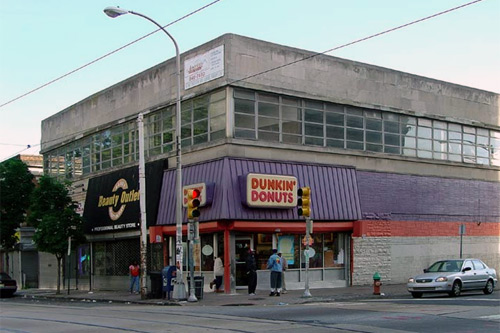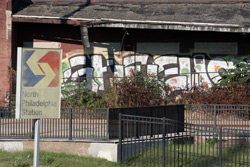6 November 07: The Possible City
Around the Mulberry Tree we go
 by Nathaniel Popkin November 6, 2007 Thanks to quite a few readers, we now have a thorough list of critical neighborhood locations to explore. The most votes seem to be for Germantown & Chelten, a spot which I've been thinking about recently as part of Hy Zelkowitz and Tod Cortlett's industrial design studio at Philadelphia University. Broad & Olney and Oxford Circle were other popular nominees. It's a terrific list of all different kinds of places, including some which are predominantly residential. I expand the MCP hospital site to include the Allegheny Avenue area that is about to lose TastyKake. Here's the complete list: North:As for one of the core ideas presented in Wondering about Wandering, the expansion of center city, Paul Levy, Center City District President and CEO, sent along his organization's 2002 report on that same idea. His analysis shows that neighborhoods with small median household size already express one of the key attributes of downtown living. With the clocks falling back for winter, Philadelphia falls into its strange annual hibernation. Neighborhoods particularly lose the rhythm of street life. This isn't a factor of chill air per se, as it's still plenty warm out, rather wholly inadequate lighting. Poor lighting means stores can't stay open late, which means they can't make enough money to stay open at all. It means it at least feels unsafe to stand -- at 33rd and Lehigh, say -- and wait for the bus, which runs less frequently at night in the winter. It's a cycle that ends in misery. The cobra lights that illuminate the middle of the street leave the building edge and sidewalk dark -- and darkness is our enemy. We need to light our sidewalks if we wish to return life to the neighborhoods. There is no more straightforward approach or a better return on investment. In the spirit of rewarding wandering, neighborhood monuments -- libraries, post offices, churches, schools, public spaces, sculpture, murals, and gardens ought to be properly lit, as they are now in Center City. Merely lighting one or two monuments per neighborhood would have the effect of reinforcing identity, clarifying the connection to history, and beckoning us out despite the date on the calendar.  While we're on the subject of relatively simple (though certainly not inexpensive) things to make things better, it's worth revisiting an idea I posited last
week: the $10 billion fund to preserve at-risk neighborhood blocks. I've come to realize this is a proposal for preservation on a grand scale and it got me
thinking of a dream Harmon Zuckerman, the epic Philadelphian who heads up the Douglass County (Nevada) planning department, has for a system of classification and
organization of architectural elements. Harmon always figured that by classifying all the stuff being picked through during demolition, Philadelphia could profit
from its demise. With the $10 billion fund, it would be possible to aggregate materials from certain seriously degraded rowhouse blocks for use on other more
strategic blocks in relatively better shape. This occurred to me while fifty six-year-olds ran around a Mulberry Tree in the side yard of a house in Fishtown.
It wasn't the tree so much as the French-style fireplace and an iron gate and the front door, etc., all assembled from various local sources, that got me
thinking. While there are a couple dealers in architectural objects, what I envision is a central warehouse and database of items from claw foot tubs to doors,
shutters, cornices, metal work, to flooring, joists, and fireplaces. Here is economic and environmental sustainability in a nice package. And potentially lots
of jobs too.
While we're on the subject of relatively simple (though certainly not inexpensive) things to make things better, it's worth revisiting an idea I posited last
week: the $10 billion fund to preserve at-risk neighborhood blocks. I've come to realize this is a proposal for preservation on a grand scale and it got me
thinking of a dream Harmon Zuckerman, the epic Philadelphian who heads up the Douglass County (Nevada) planning department, has for a system of classification and
organization of architectural elements. Harmon always figured that by classifying all the stuff being picked through during demolition, Philadelphia could profit
from its demise. With the $10 billion fund, it would be possible to aggregate materials from certain seriously degraded rowhouse blocks for use on other more
strategic blocks in relatively better shape. This occurred to me while fifty six-year-olds ran around a Mulberry Tree in the side yard of a house in Fishtown.
It wasn't the tree so much as the French-style fireplace and an iron gate and the front door, etc., all assembled from various local sources, that got me
thinking. While there are a couple dealers in architectural objects, what I envision is a central warehouse and database of items from claw foot tubs to doors,
shutters, cornices, metal work, to flooring, joists, and fireplaces. Here is economic and environmental sustainability in a nice package. And potentially lots
of jobs too.As for Jefferson University's new plaza, which I reviewed recently, it's even better at night, when the lighting scheme joins the Hamilton Building itself to feign the atmosphere of a restored ruin. (The use of large stones in the plaza and the lighting of the column forms of the building's façade leave this impression.) I had written about the need to activate the generous arcades of the Scott Library. I discovered later that there is a half-hearted attempt at a café inside the western arcade, which is really a lounge area, counter without a barista, and a collection of vending machines. It's lackluster but only reinforces the instinct to use the space for eating and drinking. Given what Jefferson has done to make the plaza feel un-like a hospital, and given how enticing the plaza is, a restaurant with tables under the arcade would merely complete the picture. The University will anyway have to consider rethinking the plaza's diagonal axis. Now, if you, as I do, walk southeast through the plaza from Walnut Street you'll run out of pathway well before the corner of 10th and Locust. Instead, you either cross the main oval and then walk through the grass to the corner or turn left in front of Dr. Gross and walk out to 10th Street. But the second alternative kills the diagonal -- which is the essential joy of using the plaza. Walking on the grass is fine, but it feels like a subversive act when it clearly needn't. –Nathaniel Popkin nathaniel.popkin@gmail.com |
|
• 29 Oct 07: Wondering about wandering • 5 Oct 07: No other way • 21 Sept 07: Here is the Possible City |
